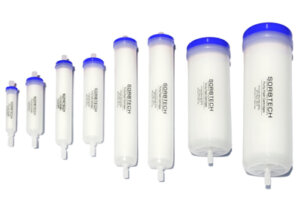 Flash chromatography is a rapid and efficient method for the purification of organic compounds. It is based on the same principles as traditional column chromatography, but uses a pressurized solvent system to achieve much faster separations.
Flash chromatography is a rapid and efficient method for the purification of organic compounds. It is based on the same principles as traditional column chromatography, but uses a pressurized solvent system to achieve much faster separations.
One of the key factors in optimizing flash chromatography separations is the choice of solvent system. The solvent system should be selected such that the desired compound has a suitable polarity and solubility. The polarity of the solvent system can be adjusted by mixing different solvents together. For example, a mixture of hexanes and ethyl acetate can be used to separate compounds of different polarity.
Another important factor is the choice of column. Flash chromatography columns are typically made of glass or plastic and are packed with a stationary phase, such as silica gel or alumina. The stationary phase should be selected based on the polarity of the compounds to be separated. For example, silica gel is a good choice for separating polar compounds, while alumina is a good choice for separating non-polar compounds.
The flow rate of the solvent system is also important. A higher flow rate will result in a faster separation, but it may also reduce the resolution. The flow rate should be adjusted to achieve a good balance between speed and resolution.
Finally, the temperature of the solvent system can also affect the separation. A higher temperature will typically result in a faster separation, but it may also cause some compounds to decompose. The temperature should be selected based on the stability of the compounds to be separated.
Here are some additional tips for optimizing flash chromatography separations:
- Make sure that the column is properly packed. A poorly packed column can lead to band broadening and reduced resolution.
- Use a pre-column to filter the solvent and sample before they enter the column. This will help to prevent the column from becoming clogged and reduce the risk of sample contamination.
- Monitor the separation closely. This can be done using a variety of methods, such as thin-layer chromatography (TLC) or ultraviolet (UV) detection.
- Collect fractions at regular intervals. This will help to ensure that all of the desired compound is collected.
- Evaporate the solvent from the fractions and test the purity of the desired compound. This can be done using a variety of methods, such as TLC, melting point analysis, or NMR spectroscopy.
By following these tips, you can optimize your flash chromatography separations and achieve the best possible results.
Here are some examples of how flash chromatography can be used to optimize the separation of specific compounds:
- Separation of enantiomers: Flash chromatography can be used to separate enantiomers, which are chiral molecules that exist as two mirror-image forms. This is done using chiral columns, which are packed with a stationary phase that contains a chiral selector. The chiral selector interacts differently with the two enantiomers, resulting in different retention times.
- Separation of natural products: Flash chromatography is often used to separate natural products, such as alkaloids and terpenes. These compounds are often complex mixtures of compounds with different polarities. Flash chromatography can be used to separate these compounds quickly and efficiently.
- Purification of synthetic compounds: Flash chromatography can also be used to purify synthetic compounds. This is often done as the final step in a multi-step synthesis. Flash chromatography can be used to remove impurities from the desired compound and achieve a high degree of purity.
Overall, flash chromatography is a versatile and powerful technique that can be used to purify a wide range of organic compounds. By optimizing the separation conditions, you can achieve high yields and purity of the desired compound.

About the Author – Randy Cooper, MBA PCM
Randy Cooper has been in marketing technology more than 35 years. He has a Bachelors of Science in Information Technology, with a focus on web development, from the University of Phoenix. He has a Masters in Business Administration, with a focus on digital marketing, from Liberty University. He holds a Professional Certified Marketer certificate from the American Marketing Association. In 2009, Randy founded Buzz My Biz, a digital marketing agency focused on giving enterprise-level marketing results to small and medium-sized businesses. In 2023 he launched RandyCooper.shop, a print-on-demand store featuring all-over-print products, and BoomerLife.social, a virtual community for boomers. When he isn’t pounding away on a keyboard, he enjoys watching the Atlanta


